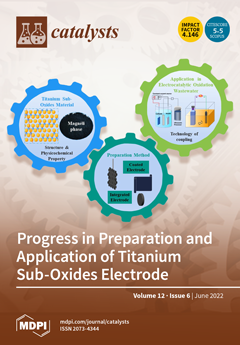MnO
2-CeO
2/PG-FA catalysts were prepared by supporting MnO
2-CeO
2 to PG-FA and used to remove Hg
0 in simulated flue gas. The results show that MnO
2-CeO
2/PG-FA catalyst had excellent and stable Hg
0 removal
[...] Read more.
MnO
2-CeO
2/PG-FA catalysts were prepared by supporting MnO
2-CeO
2 to PG-FA and used to remove Hg
0 in simulated flue gas. The results show that MnO
2-CeO
2/PG-FA catalyst had excellent and stable Hg
0 removal activity, which was mainly due to the combination effect of the catalytic oxidation activity by MnO
2-CeO
2 and the adsorption ability by PG-FA. Mn8-Ce0.5/PG-FA (with 8.0% MnO
2 and 0.5% CeO
2 loading) catalyst showed the highest Hg
0 removal efficiency at 140 °C and Hg
0 removal efficiency could be maintained above 95% with the space velocity of 6000 h
−1 and Hg
0 concentration of 160 μg/m
3. O
2 promoted Hg
0 removal by MnO
2-CeO
2/PG-FA catalyst, while SO
2 and H
2O had inhibitory effects. In the presence of O
2, the inhibitory effect of SO
2 and H
2O can be obviously weakened. MnO
2-CeO
2/PG-FA catalysts were characterized with scanning electron microscope (SEM), X-ray diffraction (XRD), X-ray photoelectron spectroscopy (XPS) and temperature-programmed desorption experiments (TPD). The results of SEM and XRD showed that the active components MnO
2-CeO
2 dispersed well on the surface of PG-FA support. The results of XPS and TPD show that the Hg
0 removal process over MnO
2-CeO
2/PG-FA catalyst included adsorption and oxidation, HgO and HgSO
4 were generated and adsorbed on the catalyst. MnO
2-CeO
2/PG-FA catalyst also showed excellent regeneration performance after Hg
0 removal.
Full article





